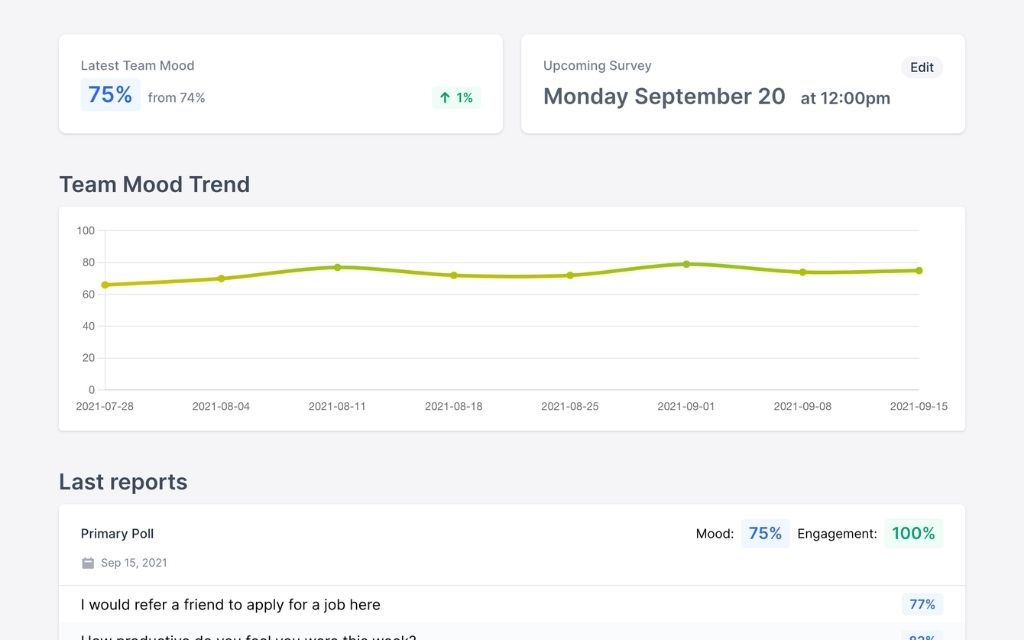You need to know these statistics to help you set up your team for success in 2024.
When employees are engaged at work, they’re happier and more productive in their roles as they do it. As a result, the business benefits from a drastic decrease in costs while increasing profits. By boosting employee engagement rate, mutual benefits will also be achieved.
Use these statistics if you’re looking for baseline info for your future steps in improving your employee engagement strategy and employee experience in 2024.
There will be 22 employee engagement statistics in this list. Read on.
What Is Employee Engagement?

Investopedia defines employee engagement as a human resources (HR) concept that describes the enthusiasm and dedication a worker feels toward their job and the company they’re working at. Investopedia also added that “engaged employees care about their work and the company's performance and feel that their efforts make a difference.
An engaged employee is in it for more than a paycheck and may consider their well-being linked to their performance, and thus instrumental to their company's success.”
High engagement provides all kinds of benefits to an organization, its employees, and even its customers. Companies with high engagement rates have better productivity, customer service, profitability, employee retention, and more.
There are three known types of employee engagement:
- Actively engaged — these are employees who are heavily invested in their work and constantly participating in providing personal inputs to help the company accomplish its goals
- Disengaged — disengaged employees are functional employees, however, exclusively doing the bare minimum for the sake of getting tasks done and getting paid
- Actively disengaged — these employees are employees who are not doing their jobs effectively and constantly spreading toxic behavior in the workplace
22 Employee Engagement Statistics to Know in 2024
Knowing and understanding statistics can give any company or organization an advantage in strategic planning. Here are the statistics you should know to prepare for 2024.
1. 23% of Employees are Actively Engaged Globally.
Gallup, an American analytics and advisory company, says that global employee engagement is 23% in 2023—the highest ever.
What could this high engagement mean? There’s an increase in employees thriving at work in 2023 compared to previous years. Employers can expect even higher numbers in 2024 as new strategies will be developed to push these numbers further. Higher employee engagement suggests a significantly good opportunity for growth in employee experience.
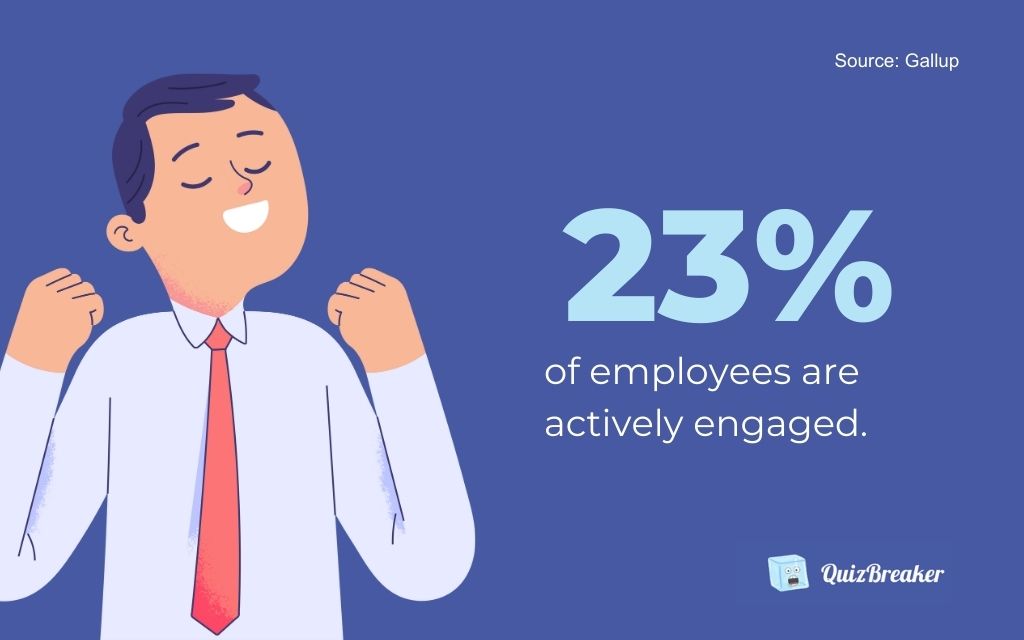
But, despite these advances, at the end of the day, only one out of every four workers is actually engaged.
This information sheds light on a bigger problem which is that 77% of the global workforce is disengaged from their job—or worse, actively disengaging.
2. Actively Disengaged Employees Cost Their Organizations $483 to $605 Billion per Year.
More than we know, many employees are quiet-quitting or doing only the bare minimum at work due to poor work environments, insufficient compensation, lack of benefits, and the absence of employee wellness programs.
Situations regarding actively disengaged employees challenge companies and organizations to reinforce their workforce and call for immediate rehabilitation of employee engagement and support strategies.
As you may know, this is a taxing matter for any business as they’re losing more money than what they’re earning simply because of workers who are showing disinterest in their jobs—actively.
Disengaged workers are byproducts of disappointing workplace conditions and experiences that ultimately lead to a lack of commitment and interest in their jobs.
With the rapid growth of the global workforce, actively disengaged workers are more common now than ever. To resolve this issue, companies must regularly monitor employee engagement and take the necessary action to address the concern of disengaged workers.
3. 73% of Employees Are Considering Leaving Their Jobs.
In the US alone, 73% of working professionals from a tight research sample are considering resigning from their jobs. This is according to a survey conducted by Joblist.
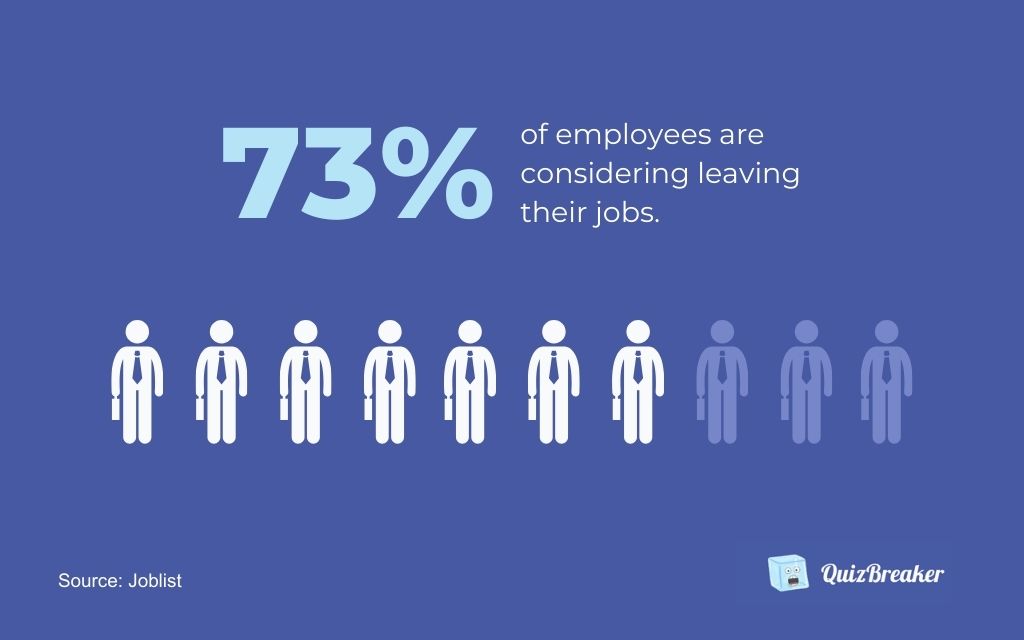
Joblist surveyed 26,000 people from the US job market. The survey covered:
- Job market challenges
- Reasons for quitting
- Job satisfaction.
One specific part of the survey asked 3,000 employees if they were considering leaving their jobs. Joblist found out that 73% of 2,099 respondents are constantly thinking about quitting their jobs, with over a quarter of these individuals comfortable resigning, even without another job ready.
Workers are leaving because of workplace factors affecting their physical, mental, and emotional health and ability to generate more income in this rapidly deteriorating economy.
4. 33% Of Employees Leave Their Jobs for New Challenges.
Employees look for new jobs due to boredom to seek new challenges. Employers should see the value of introducing new challenges and varying tasks for employees to learn and expand their knowledge to welcome new opportunities continuously.
Times have changed, and professional development is vital for every company's growth. By enhancing employee experience and skill development, employee growth will flourish, the company will grow, and employee retention will be easier.
5. Only 16% Of Firms Use Technology to Monitor Engagement.
Did you know that only 16% of the global workforce leverages technology to enhance employee engagement? Understanding the employee experience is crucial nowadays.
With the growing need to connect staff through technology, especially in remote or hybrid work environments, methods like virtual clocking in/out, tracking computer usage, and monitoring emails/chats are becoming increasingly common.
These practices help manage workflow and play an important role in maintaining team cohesion and supervision. The use of company intranet platforms is particularly useful, offering a centralized hub for communication, resource sharing, and project collaboration.
By leveraging these tools, organizations can ensure a more connected, efficient, and engaged workforce that’s highly adaptive to the evolving dynamics of the modern workplace. Interestingly enough, some companies use tools to track employee engagement and well-being rather than productivity.
Looking for a tool to measure your employee engagement levels? Check out Quizbreaker's pulse survey platform. It's one of the best ways to run hassle-free employee engagement surveys at work. What's more is we have paired this feature with many other tools to help you build workplace engagement.
6. 38% Of Remote Employees Feel Exhausted After Daily Virtual Meetings.
A recent Doodle survey of over 1,100 U.S. employees states that 38% of its sample felt exhausted after daily virtual meetings, while 30% reported feeling stressed from frequent online interactions.
This study highlights the signs of stress that stem from intense and frequent virtual meetings: employee burnout.
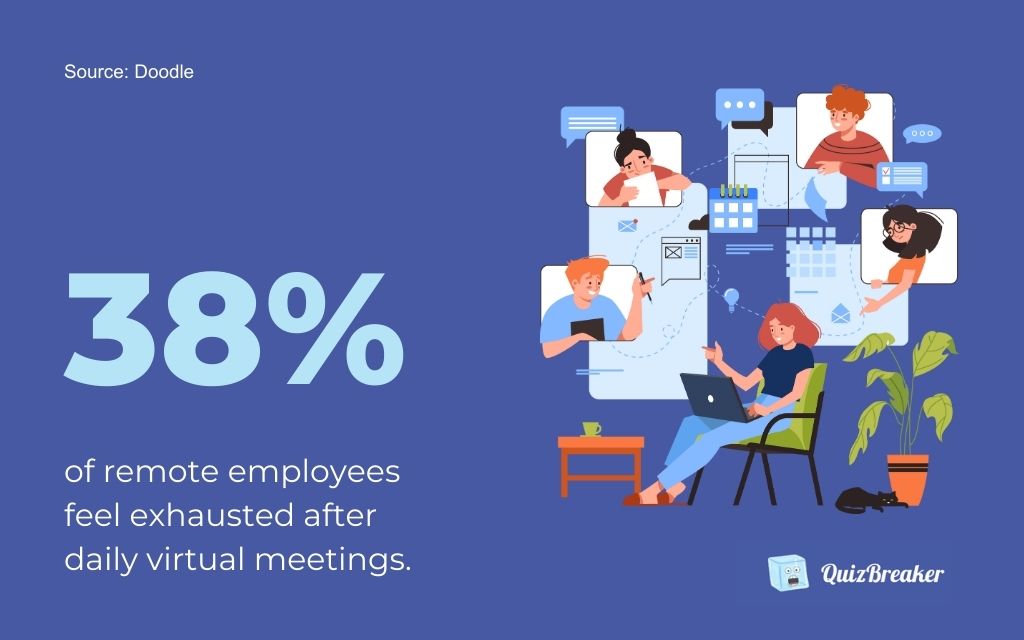
Employee burnout is a growing concern for businesses as it compromises long-term employee health and underscores organizations' need to understand what motivates and frustrates their employees. Addressing challenges like these is crucial for maintaining a healthy, productive workforce, especially as remote work continues to be common.
Employers need to find a balance in virtual collaboration to address employee burnout and promote a more sustainable work environment for their workers.
7. 85% Of Employees Are Most Motivated When Internal Communications Are Effective.
According to Trade Press Services, 85% of employees feel most motivated when they receive regular updates on company news and project progression.
Tapping in with your employees regularly to update them on company goals and challenges, along with a clear understanding of the relevance of their role in achieving those goals, is very important as it enhances employee motivation, leading to higher employee engagement and revenue increase.
8. 77% Of Companies Focus on Employee Experience to Increase Retention.
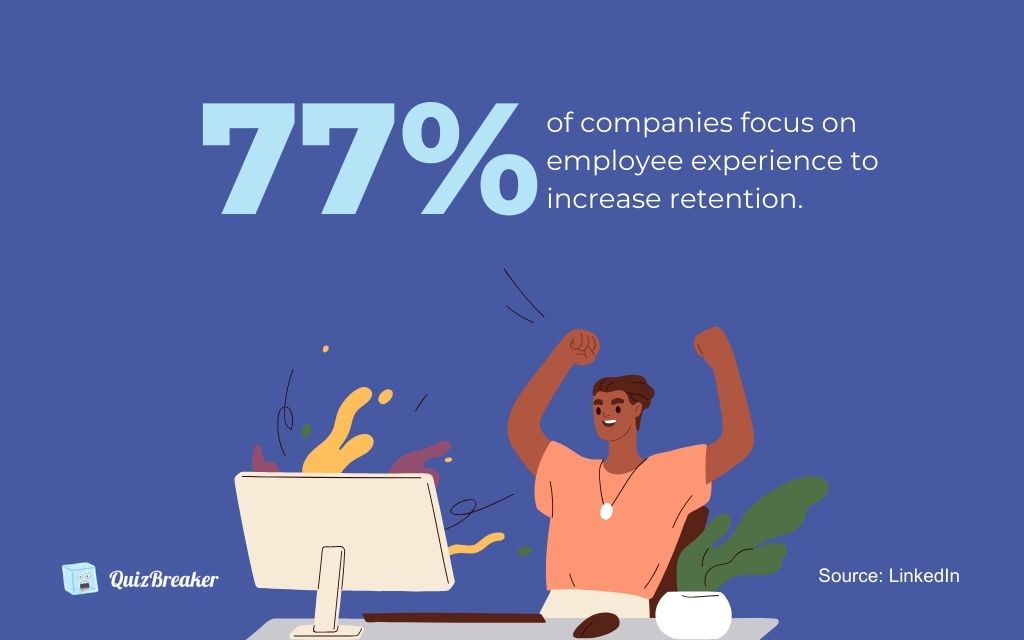
LinkedIn's Global Talent Trends 2020 report reveals that 77% of companies emphasize employee experience to improve retention. This global workplace report shows that a positive workplace experience promotes emotional attachment in employees. Those emotionally attached to their job are more likely to stay
9. 69% of Employees Report That They Would Work Harder if They Felt More Appreciated at Work.
Starting a program to recognize employees' hard work is essential.
Employees work harder and stay more engaged when they feel their efforts are appreciated by their management and employers. Moreover, 85% of employees are more motivated when regularly updated on company news.
Always give feedback where it’s due and acknowledge past achievements to show appreciation towards your employees.
Recommended Reading: 22 Best Employee Recognition Ideas for 2024 [Ranked]
10. 89% of Human Resources Professionals Claim That Providing Ongoing Feedback and Clear Expectations are Optimal for Increasing Employee Engagement.
Regular feedback and check-ins are vital if you’re looking to engage your employees. This can be easily achieved by promoting consistent co-worker feedback between employees and managers. Previously, companies modeling this system drastically boost productivity and help prevent employee burnout.
Additionally, employers and managers should:
- Clarify job roles and deadlines properly with workers
- Provide employee training and briefing that sets role expectations
- Promote work-life balance
- Respect work hours
- Give adequate compensation for extended work hours
- Update employees about the status of the company
11. Only 16% of Companies Monitor Employee Engagement!
Only a few percent of companies globally utilize technology to track employee engagement and employee progress. Productivity apps make tracking easier in today's digital age, with countless software options readily available.
This approach is especially useful for employers and managers during onboarding procedures.
12. Companies with a Thriving Corporate Culture Achieve Over 4x Higher Revenue Growth!
Companies with strong cultures have 4x the revenue growth, better chances of profitability, better retention, and employee engagement. Positive environments like these fosters employees’ initiative to problem-solve proactively, share ideas openly, and collaborate.
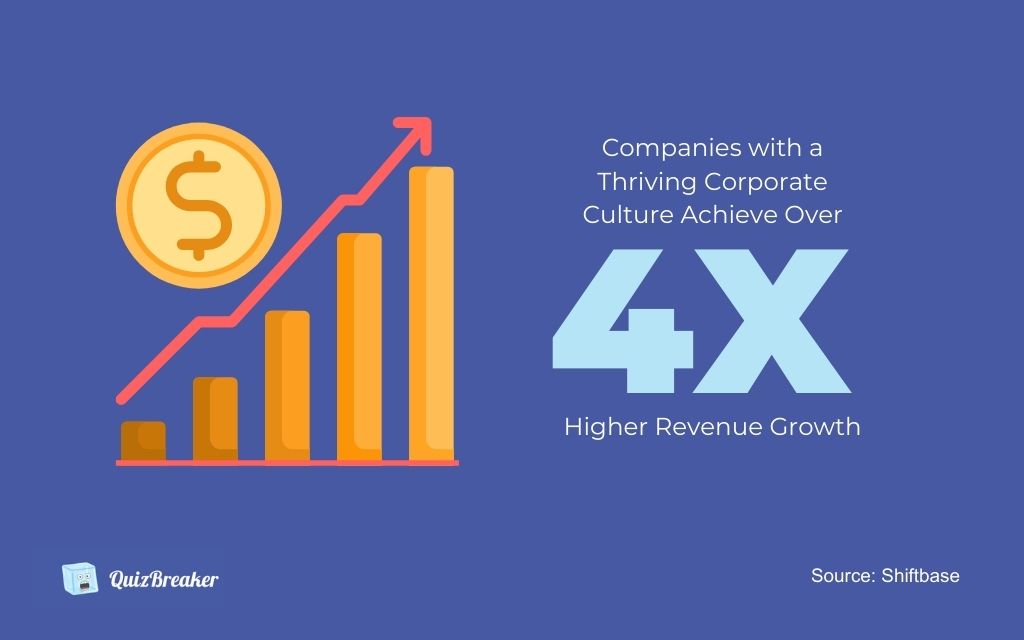
A solid and thriving corporate culture that values the owners' and employees' inputs and personal circumstances at every level always wins. Creating a challenging yet supportive environment to build such a culture is very important. Same reason why big companies and corporations prioritize positive company culture above all.
13. Companies with Highly Engaged Workforce Are 21% More Profitable.
Organizations with higher levels of employee engagement are subject to higher revenues as engaged employees are likely to be more motivated to complete deliverables on time and start a new project immediately.
Highly engaged employees often exceed basic requirements to achieve company goals and objectives. They also excel at meeting customer needs, leading to increased sales and revenue.
14. 37% of Employees Consider Recognition the Most Important.
37% of employees view recognition as the most important factor for success. Additionally, 84% of highly engaged employees were recognized the last time they went above and beyond at work and said they performed even better compared to only 25% of actively disengaged employees.
15. Only 29% of Employees Are Happy with Career Advancement Opportunities.
Giving professional development opportunities to workers is crucial if you’re strategizing for retention and employee engagement.
The demand for on-the-job professional development opportunities is especially high and considered a big factor, especially for the younger generation in the workforce, even for prospecting applicants.
This includes up to 87 percent of the Millennials in the sample who consider development in a job vital for a successful work relationship. As a resolution, organizations should invest more in opening new doors of employee development and growth for their teams.
16. Disengaged Employees Cost an Additional $3,400 for Every $10,000 in Salary.
Actively disengaged employees cost their organization 34% of their salary. For example, an employee earning $60,000 annually costs their company $20,400 due to active disengagement.
To combat this concern, employers should promote career growth by regularly discussing career paths with employees and creating a learning-focused culture. Include the development of effective managers who are also team players as they greatly impact employee satisfaction.

Emphasize diversity and inclusion to make everyone feel welcome, boosting engagement and performance. These efforts will build a more united and productive team.
17. “Per My Last Email”: 83% Of Employees Receive Passive-Aggressive Messages.
Passive-aggressive communication in the workplace negatively impacts trust, safety, and overall working conditions.
Clear, honest communication must be maintained within the team to maintain respect, trust, and productivity. The use of passive-aggressive language can disrupt teamwork and office harmony. Employers should promote the correct use of language and tone in the workplace, especially in a diverse or multicultural setting.
18. Study: 57% Of Employers Monitoring Attendance.
One survey shows that 57% of companies sampled monitor employee attendance, and almost half use direct manager feedback. Around 41% use badge swipes, sensors, or track computer locations, with 16% enforcing strict tracking.
Tracking and monitoring attendance is important for maintaining responsible and regular staff presence, especially for roles that require team effort or intensive physical work.
Attendance tracking helps reduce excessive absenteeism and maintains ongoing operations smoothly. Labor laws and rules are commonly the biggest reason for attendance tracking, as it's sometimes legally needed to record work hours. Attendance tracking is also useful for calculating employee pay, managing extra work hours, and ensuring employees are paid correctly.
19. Employees Fully Engaged with Their Work Have an 87% Less Chance of Leaving Their Current Employer.
Did you know that up to 71% of Gen Z would consider a lower-paying job with meaningful work than a high-paying job with no significance to them?
75% of employees globally would leave their current jobs for a better opportunity or even resign without applying for a backup.
Higher employee retention is seen when they are engaged and find purpose in their roles. Yet, 22% still feel disconnected from their company's purpose.
With organizations spending millions daily on replacing staff and hiring new employees to train, employers should try harder to improve retention and job satisfaction for hardworking employees instead.
Investing in employee engagement can be more cost-effective than training new staff. Organizations should strive to build work environments that value and give significance to employee roles.
20. Office Workers, Salespeople, and Construction Workers Have the Lowest Level of Engagement Among Employees, with a Mere 12% Rate.
Office, sales, and construction workers show a low employee engagement rate in workplaces, with just 12%. Using an employee engagement platform is crucial to link employees in different places.
As businesses and organizations grow, working with a team consisting of multiple members becomes harder.
With designated productivity intranet platforms and social media, team communication can boost business connections. Effective use of these platforms can bring employees closer and help them work on-sync as a team.
21. There is an 18% Decrease in Staff Turnover for Businesses that Engage Their Employees.
Organizations that reinforce establishing a workplace of active involvement foster a loyal workforce, encouraging long-term workers who are 101% committed to the organization and its goals.
Actively engaged employees globally reached an 18% decrease in staff turnover. While 0% employee turnover is impossible, the potential to realize a team of committed staff is achievable.
How To Encourage Employee Engagement

Here are ways to help you nurture employee engagement in the workplace:
1) Develop good managers
Effective management stems from empathy and kindness. Middle management plays a crucial role in every team's dynamics, as their engagement levels significantly influence team morale from the get-go. Managers must actively engage in conversations with their team members to understand individual preferences, where feedback is vital for strategizing the team’s next step forward
They must adopt a coaching mindset where support, constructive feedback, and identifying growth opportunities thrive. This approach fosters a more positive, engaged, and productive workplace. Toxic managers create toxic team members.
2) Provide learning and development opportunities
Organizations should promote employee learning and development as they can help raise the value of their worker's time and effort, which can significantly increase their value at work and their income to create new avenues for career growth.
3) Keep an eye out for employee burnout
The common causes of burnout are excessive workload, overwhelm, unrewarding work, and poor work-life balance. Always watch for signs like chronic fatigue, decreased enthusiasm, increased cynicism, and reduced employee productivity.
The solution to burnout is usually acquired by reverse-engineering these problems.
Here are a few ways toprevent or address employee burnout:
- Promote empathy and kindness in the workplace (starting with the management)
- Develop the right system and provide the right tools for workers to make jobs manageable
- Prioritize giving work-life balance and respecting work hours to prevent overworking
- Create a supportive environment for all employees.
- Develop a positive company culture that values employee contributions and provides a sense of purpose
- Providing paid time off from work
4) Provide Employee Wellness Programs
Employers can create an impactful positive work environment that fosters employee engagement and motivation by assessing their employees' well-being and providing the right employee wellness programs at the right time.
What are the benefits of employee wellness programs anyway? Employee Wellness Programs can help:
- Reduce health risks and promote longevity
- Dramatically minimize employer healthcare cost
- Improve daily motivation and accountability
- Improve productivity
- Reduce employee absenteeism
5) Invest in Employee Engagement Tools
Companies invest in tools and software, but employee engagement tools don't always get managers' and employers' attention. You should start looking into tools that will help engage workers by providing fun avenues to connect, have fun, and get to know each other better.
One tool we recommend is Quizbreaker, our all-in-one employee engagement tool. Our platform provides different ways for you to engage your team. Here are some notable features:
- Asynchronous icebreaker quizzes about your team to learn more about one another;
- A multiplayer trivia platform for fun icebreaker games;
- Workstyle profiles to get to know your teammates better;
- Pulse surveys to get your team's feedback and evaluations;
- Escape games to build camaraderie and strategic thinking;
- And more!
Try out Quizbreaker now and start engaging your team.
Frequently Asked Questions (FAQs)
How much better do engaged employees perform?
Actively engaged employees perform much better at work than their actively disengaged counterparts. If employees are more engaged with the company's progress, the better they do their job. Actively engaged workers would even go as far as making a discretionary effort just to see their work’s results through and through.
What is the global employee engagement rate in 2023?
In 2023, we had a 23% global employee engagement rate—an all-time high.
What is a good percentage of employee engagement?
Any organization's decent baseline engagement score is at least 50% or higher.
What are the results of engaged employees?
The results may vary, but the most prominent are better mutual benefits, better outputs, and better employee performance.
Other notable benefits of high employee engagement may include:
- Higher productivity — better employee performance means better and faster outputs.
- Higher job satisfaction — employees are happy and well taken care of, therefore satisfied in their career.
- Increase in employee retention — employees are happy in their workplace, they want to stick with the company.
- Easier recruitment — good word-of-mouth, sense of purpose, if people are pleased with the management, even the employees will return and bring other people with them.
- More innovation — engaged employees have the initiative to produce innovative solutions that can help the company move past its present state.
- Discretionary effort — employee’s voluntary effort to help achieve company objectives and move forward, not out of obligation but of own willingness.
- Reduced employee absenteeism — highly engaged employees are invested in the company and do not want to miss out on anything.
Final Words
Higher employee engagement is the positive outcome of establishing a good relationship with your employees. This is why organizations should also prioritize the well-being of their employees and not just the productivity and profitability of the company.
When measuring engagement levels in your organization, the best method is to ask your employees directly. Take advantage of engagement surveys on organizational apps and tools, utilize employee interviews, or even simple 1:1 conversations on a random day for spontaneity.
It’s always better to remember that employees are just people who wish to belong to something bigger than them that’s of significance and meaning—a purpose. And the best workplaces give their employees a sense of purpose.
On the other hand, employee disengagement is a sickness all companies have, and if not properly addressed, it can potentially lead to business failure. Workplace engagement statistics above highlighted the downsides of disengagement and the benefits of active engagement.
The bottom line is: For any business or organization to thrive and achieve guaranteed success, first, we take good care of our people so they care about our businesses, too.


